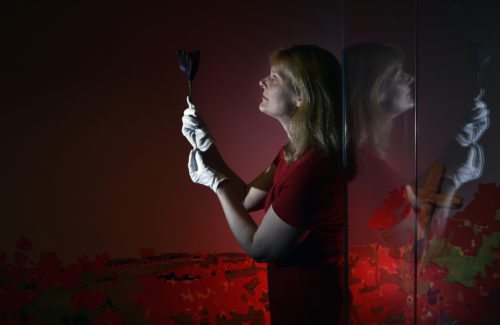Poppy exhibition marks one hundred years since the Great War
All year there are events planned to mark the centenary since the First World War ended and National Museums Scotland have just opened the final element of their commemorative exhibitions and events.

The Poppy: A Symbol of Remembrance 30 March 2018 to 27 January 2019 National War Museum, Edinburgh Castle
Elaine Edwards, exhibition co-curator holding a 1920s waxed paper car poppy, designed to be tied to the front of the vehicle by Lady Haig Poppy Factory in Edinburgh.
At the National War Museum in Edinburgh Castle there is an exhibition recording the history and significance of the poppy which is a universally accepted emblem of remembrance.
There are exhibits from PoppyScotland and the Lady Haig Poppy Factory in Warriston included in The Poppy : Symbol of Remembrance. The factory began making poppies in 1926.
Patrick Watt, exhibition co-curator, said: “The First World War claimed many millions of lives. Soldiers, sailors and airmen died overseas and were buried there, in many cases with no marked grave. Without a body to bury, families could not observe normal funeral practices. This, along with the sheer scale of the conflict, led to a new culture of grief, which was at once both national and personal and required symbolic representation. The poppy became that symbol, and gained an additional charitable function in the 1920s as their manufacture and sale became a way to raise funds for ex-servicemen and their families”.
A ceramic poppy, one of 888,246 displayed at the Tower of London in the 2014 exhibition, Bloodswept Lands and Fields of Red, introduces the conclusion of the exhibition, which explores how the symbolic legacy of the poppy has become contested in recent years through what some see as its politicisation. A film at the end of the exhibition will present interviews giving voice to a range of contemporary perspectives on these issues.
 Elaine Edwards, exhibition co-curator said: “When the poppy was introduced in the 1920s, both its purpose and symbolic meaning were clear and widely accepted.
Elaine Edwards, exhibition co-curator said: “When the poppy was introduced in the 1920s, both its purpose and symbolic meaning were clear and widely accepted.
“That core function has not changed in that poppies sold continue to raise funds for ex-service personnel and their families. However, it’s fair to say that some perceptions and attitudes associated with the symbol of the poppy are more contested in the present day, both in the case of those who choose not to wear it because they disagree with what they feel it symbolises, and also in the way that some people and commentators respond to those who make that choice.
“That discussion is both interesting and relevant in relation to the historical context, and so we will present a range of those viewpoints in the exhibition through a series of filmed interviews.”
The Poppy: A Symbol of Remembrance is now on at the National War Museum at Edinburgh Castle. Admission is free with entrance to the Castle.
Twitter: @ntlmuseumsscot
Facebook: National Museums Scotland
Photos Neil Hanna Photography
www.neilhannaphotography.co.uk
07702 246823